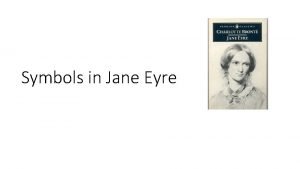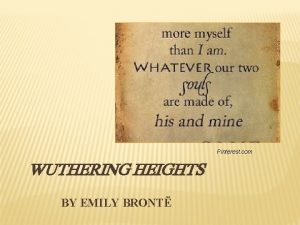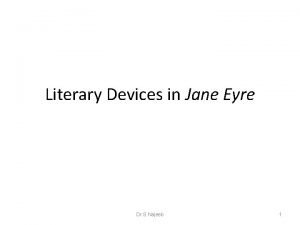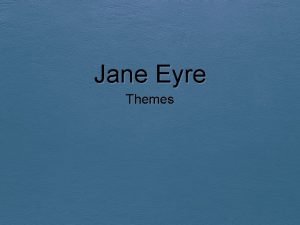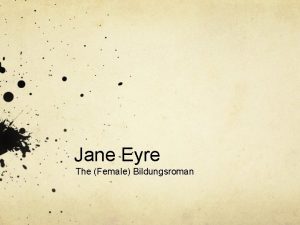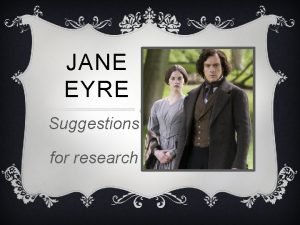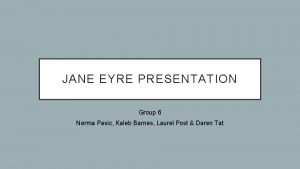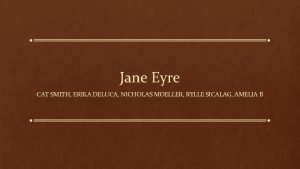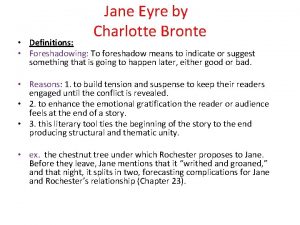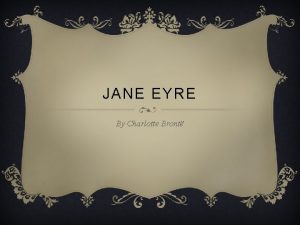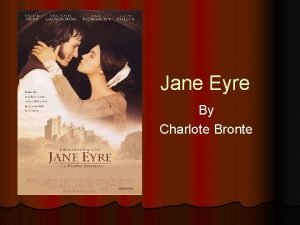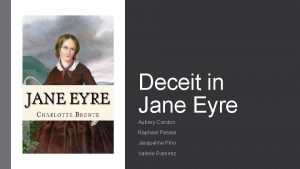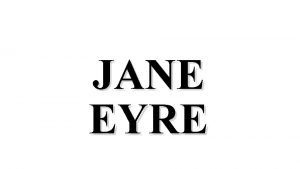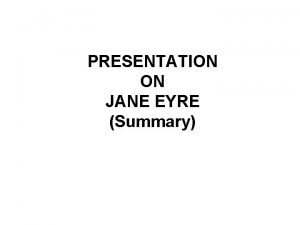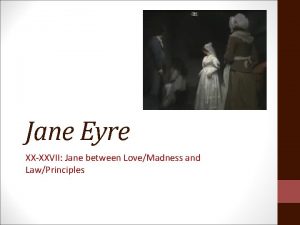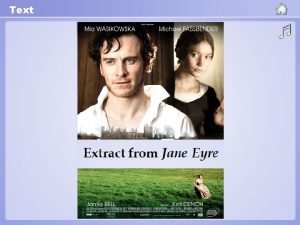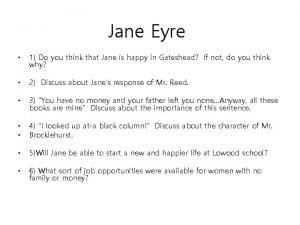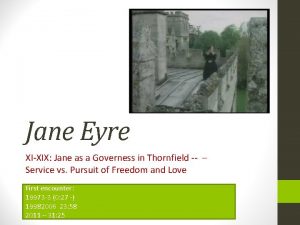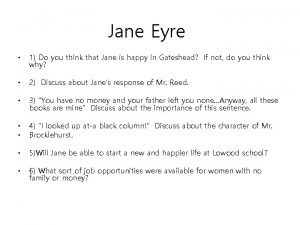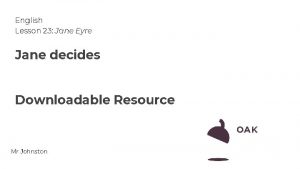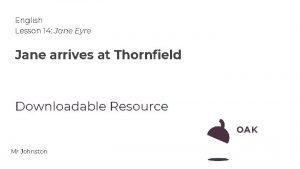Lecture 4 Reading Jane Eyre p 68 100












- Slides: 12

Lecture 4 Reading Jane Eyre (p: 68 -100) • Narrating Jane Eyre • Pictured Thoughts: Language and imagery in Jane Eyre • Jane Eyre and social comment • The governess novel and the ‘woman question’ • Realism, romance and the gothic

• Jane Eyre by Charlotte Brontë is a realist novel with a blend of voices or sub-genres. (realism, romance, domestic, gothic, bildungsroman) • Bakhtin and the concept of dialogic form “JE is a medley of competing ‘voices which’ interrupt but do not silence one another”. (p: 68) • * hybridization

Narrating Jane Eyre (p: 69 -74) • The opening of the novel: • “There was no possibility of taking a walk that day” • “cold winter” “sombre clouds” “penetrating rain” “drear November day” “a pale blank of mist and cloud” “storm-beat shrub” “long and lamentable blast”→ atmosphere outdoors reflects the protagonist’s mood. Isolated and outside. (G. H. Lewes and V. Woolf’s comment p: 80 -81) • 1 st person narrator “I was glad of it: I never liked long walks…” Direct speech • Narrator’s sensations are kept under our focus through the constant use of I and me. Tension is stressed through inversion of word order eg: “Me, she had dispensed from joining the rest of the group”. • Alienation of JE, hostile environment and combative relationship (read Chapt 1 of novel)

Jane Eyre • Jane’s story is an autobiography. It is a bildungsroman. This genre started in Germany and reflects the interest in child psychology in 18 th C. • 1 - The child Jane: We sympathize with her for being tyrannized over by John Reed • 2 - The older Jane: Interacts analytically with her situation • 3 - The mature Jane: The young woman and governess from whose narrative, the reader senses her angry and revolting younger Jane. • 1 st person narrative heightens the drama of Jane’s situation (read excerpt p: 16 &17 JE) Compare with J. Austen’s 3 rd person narrative (p 72 RN) and compare the detached voice of the adult narrator and the tension-packed voice of the child Jane • The heroine’s experiences are described from an external rather than from an internal perspective → Dramatic showing is more important in JE. • Direct address in 1 st person narrative “Reader, I married him”

• • • Recapitulation 1 st person narrative Adult narrator Dramatic showing Direct reader address Bronte alleviates the subjectivity of the narrative instigated by the child Jane.

Pictured thoughts: Language and imagery (p: 74 -82) • Bronte deviates from the conventional novel form with the intensive use of imagery- emotive adjectivesword inversion- dramatic use of syntax →poetic style of prose narrative. • Some critics claim that poetic style is remote from everyday life. J. King sees that “the literariness of JE functions as a reminder that it should not be confused • with a slice of life. ” (p: 75 RN) • Bronte’s criticism of J. Austen’s plain language. • Use of imagery → Realist and non-realist elements combine to dramatize Jane’s psyche. (p: 17 JE).

• Instances of imagery: (p: 195 -202) Rochester disguised as a gypsy • Jane’s passions, rage, desire, wind, earthquake, fire, judgment, flame, flickers in the eye, red cloak and red room…(p: 75 RN) Imagery pertaining to Jane’s visit to Mrs. Reed: (p: 23040) Icily, stony, fire and violence, ice-cold, clammy hands, eye of flint, cold lid, fire within and snow without, fire and snow: two literal metaphorical extremes. Quote the intensive use of imagery (p: 78 RN) in the opposing contrastive views which reflect Jane’s feelings

The relationship between location and imagery. 5 locations represent the stages of Jane’s development. (p: 78 RN) 1 - Gateshead, where Jane was an isolated child, in the red room. 2 - Lowood, with a harsh environ tempered by Mrs. Temple’s care. 3 - Thornfield, Jane as governess, fire connotes anticipated danger. 4 - Moor House, warm family relationship. 5 - Ferndean, balance of opposites and compromise of extremes in Jane’s character. G. H. Lewes believes that Jane has the power of connecting external appearances with internal effects.

• Bronte is inspired by Bewick’s use of imagery “ A fresh delight is found in every enchanted page where pictured thoughts… breathe and speak and burn. ” Quote V. Woolf’s praise of the Bronte sisters’ use of poetic ingenuity (p: 79. RN)

Jane Eyre and social comment (83 -8 RN) • Bronte was praised for blending ‘psychological insight with realistic experience’ • Reality not only with characters and events, but with the description of entourage, scenery and nature. • Literary and social critics: Jane Eyre is a socially engaged novel. ‘the condition of England’, a novel of its ‘decade’. (1840’s) • Marxist critics: Issues of class. Jane is exiled from her class. Struggles to identify with a secure social order. • Feminist critics: Radical ideologies of gender.

The governess novel and the woman question • The romantic type: The governess is highly-estimated by a gentleman and ends up marrying him. • The providential type: An autobiography of a heroine who experiences moral growth towards salvation and God’s providence. • Jane is a no romantic figure. “You admire her. . Love her for the strong will, honest mind, loving heart and peculiar but fascinating person. ” (p: 84. RN) • Being a governess gave Jane a partial independence. As in P&P, financial security is a crucial matter. • Female authorship. Eg of the Bronte sisters using pseudonyms, G. Eliot for Mary Evans. . (p: 88. RN)

Realism Romance and the Gothic (p: 88) • Jane Eyre is a blend of multiple ‘genres which interrupt, but do not silence each other’ • Fusion of realism and romance. • Romantic elements: symbolic, extraordinary eg: the gothic figure of the mad woman in the attic. • Pathetic fallacy: nature colored by the light of the soul: Poetic ingenuity. • Tradition of fairy tale: late discovery of her inheritance and her blood relation to the Rivers. • Realistic elements: psychological and physical detail. • Realist domestic mode of governess novels • Ordinary and contemporary • Plausibility of events and characters
 100 100 100 100 100
100 100 100 100 100 Symbols in jane eyre
Symbols in jane eyre Who wrote wuthering heights
Who wrote wuthering heights Personification in jane eyre
Personification in jane eyre Themes in jane eyre
Themes in jane eyre Bildungsroman jane eyre
Bildungsroman jane eyre The supernatural in jane eyre
The supernatural in jane eyre Supernatural elements in jane eyre
Supernatural elements in jane eyre Archetypes in jane eyre
Archetypes in jane eyre Foreshadowing in jane eyre
Foreshadowing in jane eyre Charlotte bronte characters
Charlotte bronte characters Charlote bronte
Charlote bronte Deceit in jane eyre
Deceit in jane eyre

